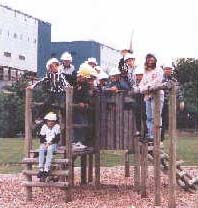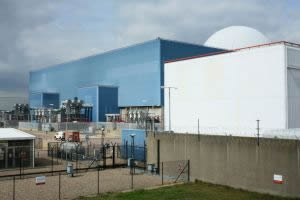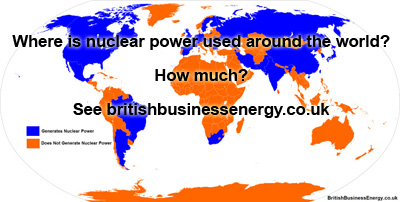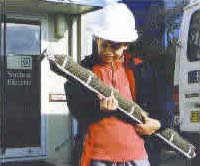Can't see the menu?
Try the text links at the bottom.
Energy Resources:
Nuclear power
Nuclear power:
Energy from splitting Uranium atoms

| |
|
|
|
Nuclear power is generated using Uranium, which is a metal mined in various parts of the world. The first large-scale nuclear power station opened at Calder Hall in Cumbria, England, in 1956. Some military ships and submarines have nuclear power plants for engines. Nuclear power produces around 11% of the world's energy needs, and produces huge amounts of energy from small amounts of fuel, without the pollution that you'd get from burning fossil fuels. |
|
The
main bit to remember: 
Nuclear power stations work in pretty much the same way as fossil fuel-burning stations, except that a "chain reaction" inside a nuclear reactor makes the heat instead. The reactor uses Uranium rods as fuel, and the heat is generated by nuclear fission: neutrons smash into the nucleus of the uranium atoms, which split roughly in half and release energy in the form of heat. Carbon dioxide gas or water is pumped through the reactor to take the heat away, this then heats water to make steam. The steam drives turbines which drive generators. Modern nuclear power stations use the same type of turbines and generators as conventional power stations. |
Video clip: Nuclear
reactor |
In Britain, nuclear power stations are often built on the coast, and use sea water for cooling the steam ready to be pumped round again. This means that they don't have the huge "cooling towers" seen at other power stations.
The reactor is controlled with "control rods", made of boron, which absorb neutrons. When the rods are lowered into the reactor, they absorb more neutrons and the fission process slows down. To generate more power, the rods are raised and more neutrons can crash into uranium atoms.
Natural uranium is only 0.7% "uranium-235", which is the type of uranium that undergoes fission in this type of reactor. The rest is U-238, which just sits there getting in the way. Modern reactors use "enriched" uranium fuel, which has a higher proportion of U-235. The fuel arrives encased in metal tubes, which are lowered into the reactor whilst it's running, using a special crane sealed onto the top of the reactor. With an AGR or Magnox station, carbon dioxide gas is blown through the reactor to carry the heat away. Carbon dioxide is chosen because it is a very good coolant, able to carry a great deal of heat energy. It also helps to reduce any fire risk in the reactor (it's around 600 degrees Celsius in there) and it doesn't turn into anything nasty (well, nothing long-lived and nasty) when it's bombarded with neutrons. You have to be very careful about the materials you use to build reactors - some materials will turn into horrible things in that environment. If a piece of metal in the reactor pressure vessel turns brittle and snaps, you're probably in trouble - once the reactor has been built and started you can't go in there to fix anything.. |
|
Uranium itself isn't particularly radioactive, so when the fuel rods arrive at the power station they can be handled using thin plastic gloves. A rod can last for several years before it needs replacing.
|
Should I worry about nuclear power? Nuclear power stations are not atomic bombs waiting
to go off, and are not prone to "meltdowns". |
With reactors in the UK, the computers will shut the reactor down automatically if things get out of hand (unless engineers intervene within a set time). At Chernobyl, in Ukraine, they did not have such a sophisticated system, indeed they over-rode the automatic systems they did have. When they got it wrong, the reactor overheated, melted and the excessive pressure blew out the containment system before they could stop it. Then, with the coolant gone, there was a serious fire. Many people lost their lives trying to sort out the mess. A quick web search will tell you more about this, including companies who operate tours of the site. |
| If something does go wrong in a really big way, much of the world could be affected - some radioactive dust (called "fallout") from the Chernobyl accident landed in the UK. That's travelled a long way. With AGR reactors (the most common type in Britain) there are additional safety systems, such as flooding the reactor with nitrogen and/or water to absorb all the neutrons - although the water option means that reactor can never be restarted. So should I worry? I think the answer is "so long as things are being done properly, I don't need to worry too much. The bit that does worry me is the small amount of high-level nuclear waste from power stations. Although there's not much of it, it's very, very dangerous and we have no way to deal with it apart from bury it and wait for a few thousand years... |
 |
There are many different opinions about nuclear power, and it strikes me that most of the people who protest about it don't have any idea what they're talking about. But please make up your own mind, find out as much as you can, and if someone tries to get you to believe their opinion ask yourself "what's in it for them?"
|
- Although not much waste is produced, it is very, very
dangerous.
It must be sealed up and buried for many thousands of years to allow the radioactivity to die away.
For all that time it must be kept safe from earthquakes, flooding, terrorists and everything else. This is difficult.
- Nuclear power is reliable, but a lot of money has to
be spent on safety - if it does go wrong, a nuclear accident
can be a major disaster.
People are increasingly concerned about this - in the 1990's nuclear power was the fastest-growing source of power in much of the world. In 2005 it was the second slowest-growing.
| Nuclear energy from Uranium is not
renewable.
Once we've dug up all the Earth's uranium and used it, there isn't any more. |
Actually, it's not that simple - we can use "fast breeder" reactors to convert uranium into other nuclear fuels whilst also getting the energy from it. There are two types of breeder reactors - ones that make weapons-grade plutonium and ones that are for energy production. |
| Download GCSE worksheet based on this web page |

Home Fossil Fuels Nuclear Power Solar Power Wind Power Tidal Power Hydroelectric Power Pumped Storage Wave Power Geothermal Power
Biomass Biogas Other Biofuels See also "Stuff to do" on the home page.
This site uses images from www.freefoto.com and www.sxc.hu I am not responsible for the content of external sites linked from this page.


